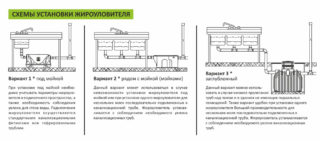The fatty impurities contained in the drains can block the pipe lumen, causing a blockage. Fatty acids lead to rust and destroy pipes, causing the line to stop functioning. The problem is solved by special devices - grease traps connected to the sewage system.
Scope of grease traps
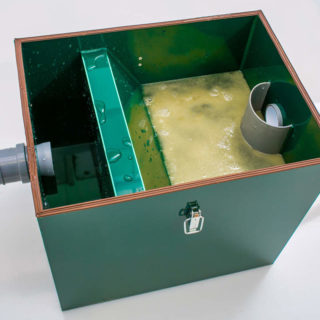
An important function of the grease trap is the filtration of wastewater from fatty, oil impurities and solid particles that pollute the environment.
Grease traps used in everyday life are installed in the kitchens of apartments, private houses, as well as in catering establishments: restaurants, cafes, canteens. Appliances are placed directly under the sinks, or placed separately. They serve to retain fat washed off from soiled dishes. The devices are cleaned manually.
In addition, exhaust ventilation systems are equipped with special grease traps.
Industrial grease traps are installed at large production facilities with a large amount of oils, greases and fatty impurities in the effluent. The cleaning of industrial grease traps is an automatic mechanized process. In accordance with the norms of the current SNiPs, grease traps are installed outside the premises of the enterprise. For example, in a sewer well located near a building.
Design features and principle of operation
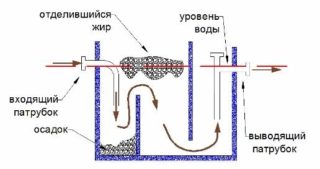
Structurally, grease traps for domestic and industrial sewerage do not differ. They consist of the following elements:
- compartment for collecting fat and oil;
- flasks with 2-3 compartments, in which the drains settle;
- inlet pipe;
- an outlet pipe connected to the sewer pipeline;
- removable airtight lid to prevent unpleasant odors.
The principle of operation of the grease separator lies in the different density of the waste components. Since water is heavier, greasy particles float up. Entering the first compartment, the water flow gradually rises, and the fat accumulating on the surface is directed to the compartment intended for it. For the most part, defatted water flows into the second chamber, where the liquid is completely purified from oil impurities that are not retained in the first compartment.
Special enzymes can be added to the installation, the purpose of which is to break down the accumulated fat. Their action significantly increases the time interval between cleansing of the grease separator.
Material selection
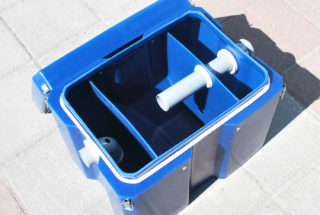
Grease traps are available in plastic, fiberglass or stainless steel or galvanized steel. The first ones are used in everyday life, for this reason they are mounted indoors. Positive features include:
- Environmental friendliness. The polymer material is not hazardous to the environment and human health.
- Practicality. Plastic allows manufacturers to make installations of standard dimensions, while taking into account the individual needs of customers.
- Easy to maintain. The device can be cleaned manually using household chemicals.
- Durability. Plastic has a long service life, the installation can work up to 30 years.
For the normal functioning of grease traps, it is recommended to use a sensor for the level of fat and oil deposits. The price of a polypropylene grease trap for sewage starts at 4000 rubles.
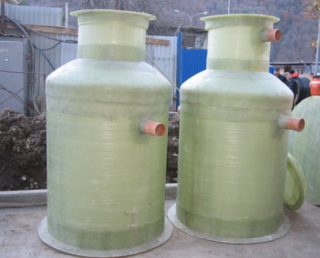
Fiberglass is made from fiberglass and a polymer binder.Fat separators have high strength characteristics. Thanks to this, they can be mounted indoors and outdoors.
Advantages of fiberglass grease trap:
- Resistant to aggressive environments.
- Increased strength.
- Lightweight and easy to clean - the devices are easy to clean.
The cost of fiberglass models is from 7,000 rubles.
Fat separators made of durable stainless steel are the most expensive of their kind. It is allowed to be mounted outdoors and indoors. Grease traps are also produced from galvanized steel. The quality indicators of these installations are lower than those of stainless steel devices.
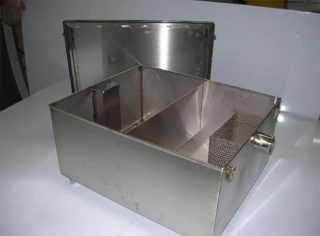
Grease traps made of stainless steel are distinguished by increased hygienic qualities, excellent performance indicators, and a long service life. In addition, they are not afraid of rust.
The price of steel products starts at 13,000 rubles. Professional devices cost from 120,000 rubles.
Selection recommendations
Before choosing a grease separator, determine the location of the device. With this in mind, a design is chosen not only in terms of dimensions, but also in terms of the material from which it is made. For outdoor installation, fiberglass separators or stainless steel products will be needed.
Grease catchers vary in power and performance. Units with a productivity of up to two liters per second are domestic.
Apparatuses with a capacity of more than two liters per second are classified as structures installed in production. Fat separators provide effective purification of effluents from fat-containing impurities up to 20 mg / l.
The performance of the device must correspond to the volume of wastewater entering the unit, or exceed this indicator.
Features of installation and operation
The separator is realized, as a rule, assembled with already installed and sealed connecting pipes or rubber adapters. No special tools are required for installation work. It is worth stocking up only with silicone sealant.
Do-it-yourself installation of a home grease separator on the sewer is carried out according to the following scheme:
- Determine the location of the separator: under the sink, washbasin or at the point of discharge from several plumbing fixtures.
- Prepare the surface for the apparatus. It must be horizontal, otherwise the waste will overflow.
- They check that the package contains all the necessary fittings and fasteners.
- Attach the grease trap to the sewer pipes in accordance with the manual.
- The test is carried out before the first cleaning of the appliance. If there are no complaints, you can close the separator with a box.
During the installation of the grease trap, seal all joints with sanitary silicone sealant, fum tape or other materials so that no leaks occur in the future.
The installation of large industrial installations outside the premises is carried out by professionals, since it requires the creation of a foundation pit and concreting.
Grease traps require systematic maintenance. To do this, you need to remove the top cover, and then remove the layer of fat that has accumulated inside with a special spatula. Separators are washed with ordinary household chemicals.
The efficiency of the grease trapping device is possible only at a wastewater temperature of no more than 40 degrees Celsius. If the temperature is higher, the fats will begin to actively melt, which will lead to a decrease in the efficiency of wastewater treatment.

